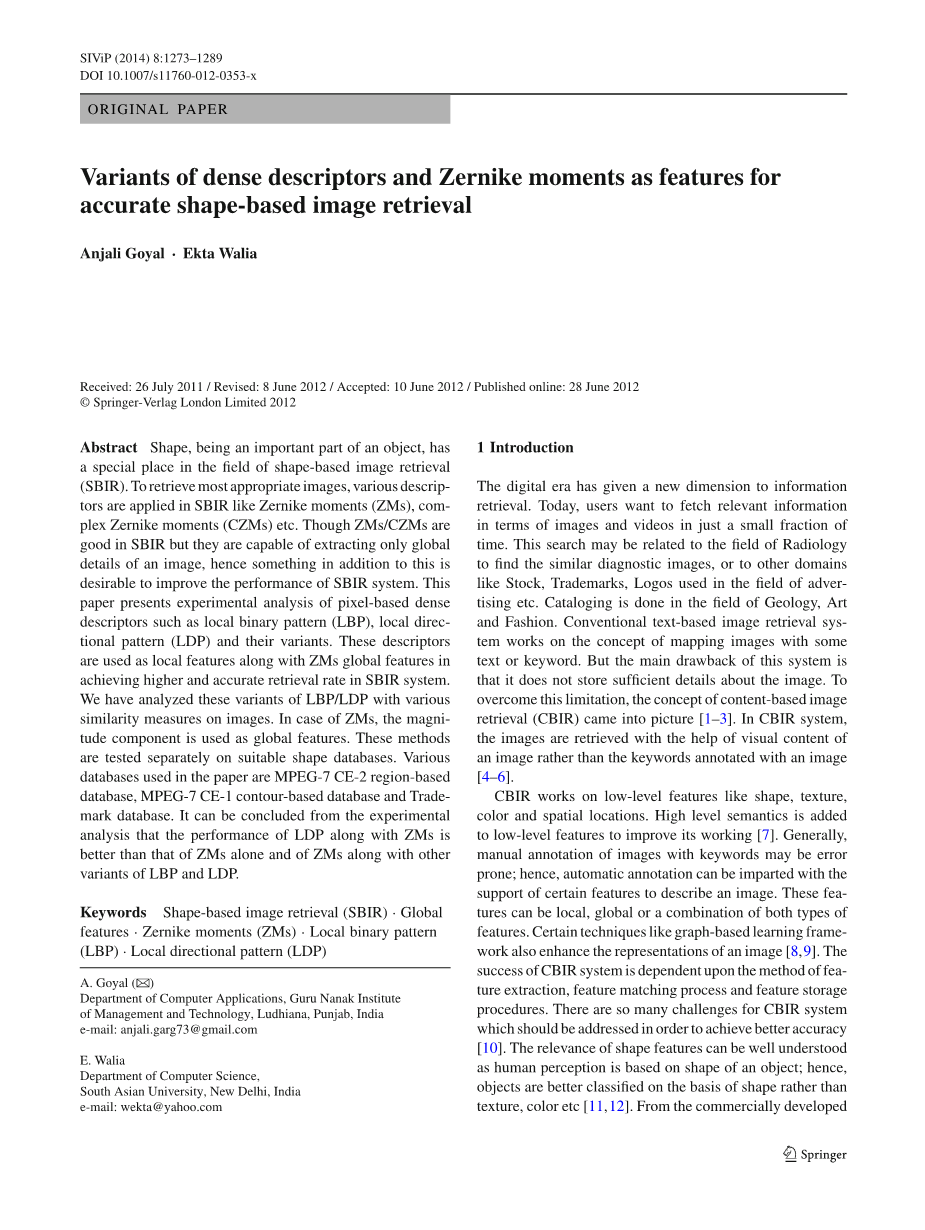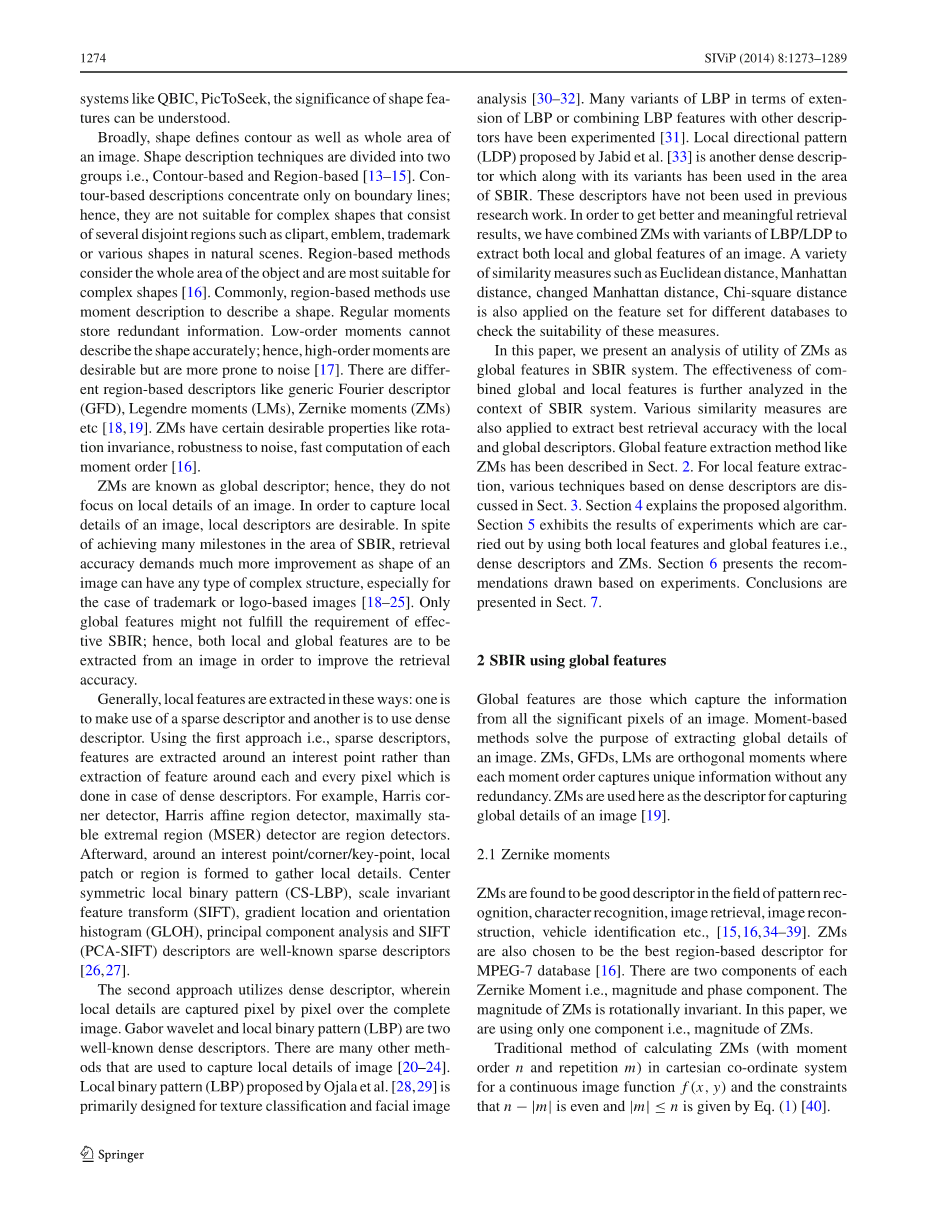

英语原文共 17 页,剩余内容已隐藏,支付完成后下载完整资料
原文:
1 Introduction
The digital era has given a new dimension to information
retrieval. Today, users want to fetch relevant information
in terms of images and videos in just a small fraction of
time. This search may be related to the field of Radiology
to find the similar diagnostic images, or to other domains
like Stock, Trademarks, Logos used in the field of advertising
etc. Cataloging is done in the field of Geology, Art
and Fashion. Conventional text-based image retrieval system
works on the concept of mapping images with some
text or keyword. But the main drawback of this system is
that it does not store sufficient details about the image. To
overcome this limitation, the concept of content-based image
retrieval (CBIR) came into picture [1–3]. In CBIR system,
the images are retrieved with the help of visual content of
an image rather than the keywords annotated with an image
[4–6].
CBIR works on low-level features like shape, texture,
color and spatial locations. High level semantics is added
to low-level features to improve its working [7]. Generally,
manual annotation of images with keywords may be error
prone; hence, automatic annotation can be imparted with the
support of certain features to describe an image. These features
can be local, global or a combination of both types of
features.Certain techniques like graph-based learning framework
also enhance the representations of an image [8,9]. The
success of CBIR system is dependent upon themethod of feature
extraction, feature matching process and feature storage
procedures. There are so many challenges for CBIR system
which should be addressed in order to achieve better accuracy
[10]. The relevance of shape features can be well understood
as human perception is based on shape of an object; hence,
objects are better classified on the basis of shape rather than
texture, color etc [11,12]. From the commercially developedsystems likeQBIC, PicToSeek, the significance of shape features
can be understood.
Broadly, shape defines contour as well as whole area of
an image. Shape description techniques are divided into two
groups i.e., Contour-based and Region-based [13–15]. Contour-
based descriptions concentrate only on boundary lines;
hence, they are not suitable for complex shapes that consist
of several disjoint regions such as clipart, emblem, trademark
or various shapes in natural scenes. Region-based methods
consider thewhole area of the object and aremost suitable for
complex shapes [16]. Commonly, region-based methods use
moment description to describe a shape. Regular moments
store redundant information. Low-order moments cannot
describe the shape accurately; hence, high-order moments are
desirable but are more prone to noise [17]. There are different
region-based descriptors like generic Fourier descriptor
(GFD), Legendre moments (LMs), Zernike moments (ZMs)
etc [18,19]. ZMs have certain desirable properties like rotation
invariance, robustness to noise, fast computation of each
moment order [16].
ZMs are known as global descriptor; hence, they do not
focus on local details of an image. In order to capture local
details of an image, local descriptors are desirable. In spite
of achieving many milestones in the area of SBIR, retrieval
accuracy demands much more improvement as shape of an
image can have any type of complex structure, especially for
the case of trademark or logo-based images [18–25]. Only
global features might not fulfill the requirement of effective
SBIR; hence, both local and global features are to be
extracted from an image in order to improve the retrieval
accuracy.
Generally, local features are extracted in theseways: one is
to make use of a sparse descriptor and another is to use dense
descriptor. Using the first approach i.e., sparse descriptors,
features are extracted around an interest point rather than
extraction of feature around each and every pixel which is
done in case of dense descriptors. For example, Harris corner
detector, Harris affine region detector, maximally stable
extremal region (MSER) detector are region detectors.
Afterward, around an interest point/corner/key-point, local
patch or region is formed to gather local details. Center
symmetric local binary pattern (CS-LBP), scale invariant
feature transform (SIFT), gradient location and orientation
histogram (GLOH), principal component analysis and SIFT
(PCA-SIFT) descriptors are well-known sparse descriptors
[26,27].
The second approach utilizes dense descriptor, wherein
local details are captured pixel by pixel over the complete
image. Gabor wavelet and local binary pattern (LBP) are two
well-known dense descriptors. There are many other methods
that are used to capture local details of image [20–24].
Local binary pattern (LBP) proposed by Ojala et al. [28,29] is
primarily designed for texture classification and facial imageanalysis [30–32]. Many variants of LBP in terms of extension
of LBP or combining LBP features with other descriptors
have been experimented [31]. Local directional pattern
(LDP) proposed by Jabid et al. [33] is another dense descriptor
which along with its variants has been used in the area
of SBIR. These descriptors have not been used in previous
research wo
全文共37876字,剩余内容已隐藏,支付完成后下载完整资料
资料编号:[17354],资料为PDF文档或Word文档,PDF文档可免费转换为Word
以上是毕业论文外文翻译,课题毕业论文、任务书、文献综述、开题报告、程序设计、图纸设计等资料可联系客服协助查找。


